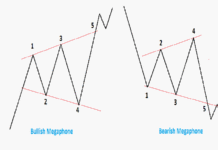
A trendline indicator is a technical analysis tool used in financial markets, particularly in the analysis of price charts for stocks, commodities, currencies, and other assets. Its primary purpose is to help traders and investors identify and visualize the prevailing direction of a price trend. Trendlines are drawn by connecting key price points on a chart, such as swing highs or swing lows, and they provide a visual representation of the trend’s slope and potential support or resistance levels.
Here’s how to use a trendline indicator:
Identify Key Points:
To draw a trendline, you need to identify significant price points on the chart. For an uptrend, look for successive higher swing lows, and for a downtrend, look for successive lower swing highs.
Draw the Line:
Once you’ve identified these points, draw a straight line connecting them. For an uptrend, this line will have a positive slope, and for a downtrend, it will have a negative slope.
Interpretation:
- Support and Resistance: In an uptrend, the trendline typically acts as a level of support, meaning that prices often bounce off it when they pull back. In a downtrend, the trendline acts as a level of resistance, with prices often failing to break above it on rallies.
- Trend Continuation or Reversal: If prices break below an uptrend line or above a downtrend line, it could signal a potential trend reversal. Conversely, if prices continue to respect the trendline, it suggests the trend is intact.
Confirmation:
It’s essential to use other technical indicators or analysis techniques to confirm the signals provided by trendlines. This can help reduce false signals and improve trading decisions.
There are various types of trendlines, including:
- Linear Trendlines: These connect two or more price points in a straight line and are the most common type.
- Channel Trendlines: These involve drawing two parallel trendlines, one above and one below the price, to define a price channel. Traders look for trading opportunities when the price reaches the channel boundaries.
- Logarithmic Trendlines: These are used when price movements occur at varying percentages. They are particularly useful for long-term trend analysis.
Trendline indicators can be drawn manually on price charts or generated automatically by charting software. They are a valuable tool for technical analysis, helping traders make informed decisions about entering or exiting trades based on the prevailing trend direction. However, it’s important to remember that no indicator is foolproof, and traders should use trendlines in conjunction with other technical and fundamental analysis tools to make well-rounded trading decisions.
A trendline is a straight line that connects two or more price points on a chart. It is used to show the overall direction of the market. A trendline can be upward-sloping, downward-sloping, or horizontal.
An upward-sloping trendline indicates that the market is in an uptrend. A downward-sloping trendline indicates that the market is in a downtrend. A horizontal trendline indicator shows that the market is range bound.
Trendlines are useful for identifying support and resistance levels as well as for spotting breakout opportunities. When prices break below an upward-sloping trendline, it signals that the uptrend may be over and prices could start to fall lower. Similarly, when prices break above a downward-sloping trendline, it signals that the downtrend may be over and prices could start to rise higher.
Related Articles:
Forex Patterns : Mastering A Key Reversal Pattern in Trading




























